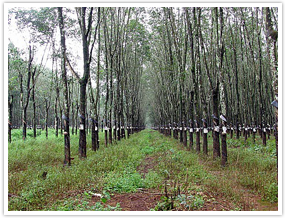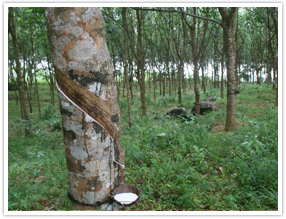| CALL US ON: +91 9900066400 FOR UPDATES AND LATEST NEWS |
|
|
Rubber
 India is the third largest producer and the fourth largest consumer of natural rubber. It is a native of the Amazon basin and introduced from there to countries in the tropical belts of Asia and Africa during the late 19th century. Rubber can be grown from sea level up to an altitude of 500 m in areas with a well-distributed annual rainfall of not less than 200 cm, and a warm, humid equatorial climate (21-35ºC). Rubber plantations in India are mostly situated on sloping and undulating lands of Karnataka, Kerala, Orissa etc. About 150 to 200 trees are planted in contour or triangular method in an acre.
India is the third largest producer and the fourth largest consumer of natural rubber. It is a native of the Amazon basin and introduced from there to countries in the tropical belts of Asia and Africa during the late 19th century. Rubber can be grown from sea level up to an altitude of 500 m in areas with a well-distributed annual rainfall of not less than 200 cm, and a warm, humid equatorial climate (21-35ºC). Rubber plantations in India are mostly situated on sloping and undulating lands of Karnataka, Kerala, Orissa etc. About 150 to 200 trees are planted in contour or triangular method in an acre.
 Rubber trees mature in 6 to 7 years and are ready to be tapped. The main crop from a rubber plantation is latex, a milky white dispersion of rubber in water, which is harvested by the tapping process. Tapping is the process of collecting milky white latex by cutting into its bark once every two days, throughout the year, except during winter and heavy rainy seasons. The processing of latex into rubber involves the mixing of a creaming agent, sheet making, drying, smoking and bundling. Economic life period in rubber plantations, in general, is around 32 years. The trees are then cut down and sold for timber. With proper management, a single tree can produce up to 1,400 kg of saleable latex per year.
Rubber trees mature in 6 to 7 years and are ready to be tapped. The main crop from a rubber plantation is latex, a milky white dispersion of rubber in water, which is harvested by the tapping process. Tapping is the process of collecting milky white latex by cutting into its bark once every two days, throughout the year, except during winter and heavy rainy seasons. The processing of latex into rubber involves the mixing of a creaming agent, sheet making, drying, smoking and bundling. Economic life period in rubber plantations, in general, is around 32 years. The trees are then cut down and sold for timber. With proper management, a single tree can produce up to 1,400 kg of saleable latex per year.

![]()
All rights reserved © | Privacy policy








